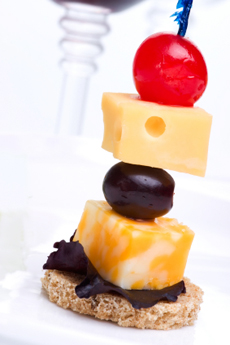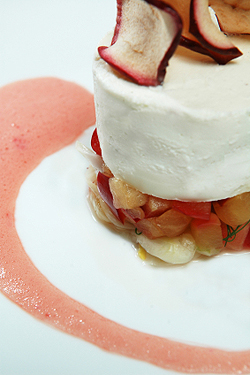

Everything from cheese plates to canapes can have more zing with flavored cheese. Here, Jalapeno Co-Jack from Loleta Cheese Factory and Emmenthaler are combined with red-leaf lettuce, a pitted olive and a grape tomato on a toasted bread round (first toast, then use a cookie cutter). Photo by Eugene Bochkarev | IST.
|
STEPHANIE ZONIS focuses on good foods and the people who produce them.
|
|
April 2008
|
 |
Flavored Artisan Cheese: Beyond Smoke & Herbs
There Are Beer, Chocolate, Flowers, & Hot Chiles In Artisan Cheeses
CAPSULE SUMMARY: You may not have thought of cheeses as “flavored” before. But take a look at the index below and you’ll nod in recognition. Stephanie Zonis, who has eaten many a fine cheese, takes a look at some of the interesting ones in each category. There’s more than enough for you to have six different cheese-tasting parties, focusing on each style. This is Part I of a six-part article. You can click to the different sections via the yellow box, below.
Overview Of Flavored Cheese
Purists normally like cheeses in their natural state. The flavor of a fine cheese stands on its own—in fact, the palate seeks out every nuance of the animal’s milk and its terroir. Nonetheless, there are times when the taste buds crave something new and different—some zip and zing. This is the time to turn to flavored cheeses. As this is THE NIBBLE, you know we’re not referring to Port Wine Cheddar from the supermarket, or other color-added, stabilizer-added, flavored spreads or logs that contain ingredients like water, corn syrup solids, or xanthan gum. Some of the nation’s best artisan cheesemakers make flavored cheeses, so you can enjoy fine cheese with a twist in taste.
Many companies make flavored cheeses, from smoked to hot jalapeño varieties. It’s common to find cheeses like pepper jack, herbed chèvre and horseradish or cranberry Cheddar in supermarkets. If you enjoy those cheeses, you’ll especially enjoy the artisan varieties. This is not to imply that all cheeses found in a supermarket are unworthy of your attention; but check the ingredients label. Quality cheese is a natural product made by curdling milk with an acid (vinegar, lemon juice) or rennet. It simply doesn’t contain things like soybean oil or sodium alginate. Given the option, why would you spend your money on (or have to eat) a highly-processed product that does?
In fact, there are so many different types of flavored artisan cheeses, even from the U.S. alone, that instead of listing them by type of cheese, this article lists them by flavoring source. This article doesn’t hope to cover even a fraction of them, just to give you a little taste of what’s out there. In addition to exploring online, try to seek out your local or regional cheesemakers. Beyond a fun visit to the nearest Farmer’s Market, a day trip to the nearest creamery is a fun outing.
The Great Smokies: Smoked Cheeses
Smoked cheeses are familiar to most people, and are popular for snacking and sandwiches. Cheeses that are smoked tend to start out as milder in nature. Smoking a more potent cheese will produce a product that is too strongly-flavored for most people.
Cheeses are smoked over a variety of materials, including applewood (Haystack Mountain’s chèvre is an example, made in Colorado) and pecan shells (Mozzarella Company’s Scamorza and Smoked Mozzarella, from Dallas). Taylor Farm Maple Smoked Gouda of Vermont, was highlighted in a prior article. Cheddar smoked with maple chips and corn cobs is available from Crowley Cheese Company, also in Vermont. Stoney Acres Sheep Dairy in Misssouri hickory-smokes its Lambert, which they list as a “mild aged cheese.” Walnut shells, cherry wood, and wood combinations of material (apple and cherry, hickory and maple, for example) are also used to add flavor to cheeses via smoking.
Smoking any cheese must be done with care and caution. If there is excessive heat during the process, the cheese could be ruined. While the objective is to impart flavor, too much heat can cause the cheese to soften or even begin to melting! To avoid this, cheeses are often cold-smoked for a long period of time. Cold-smoking allows a cheese to develop a complex, smoky taste without exposing it to direct heat. You can shop locally for smoked cheeses, or put together a tasting of those mentioned here, from these creameries:
|

A slice of smoked chèvre from Haystack Mountain, served atop a fruit salad, topped with apple chips and garnished with beet foam. Photo by Daniel Williams | IST. The log of smoked chèvre is as white as fresh chèvre. |
Proceed to Part II: Cheeses With Alcohol
Go To The Article Index At The Top Of The Page
Lifestyle Direct, Inc. All rights reserved. Images are the copyright of their respective owners.

|





